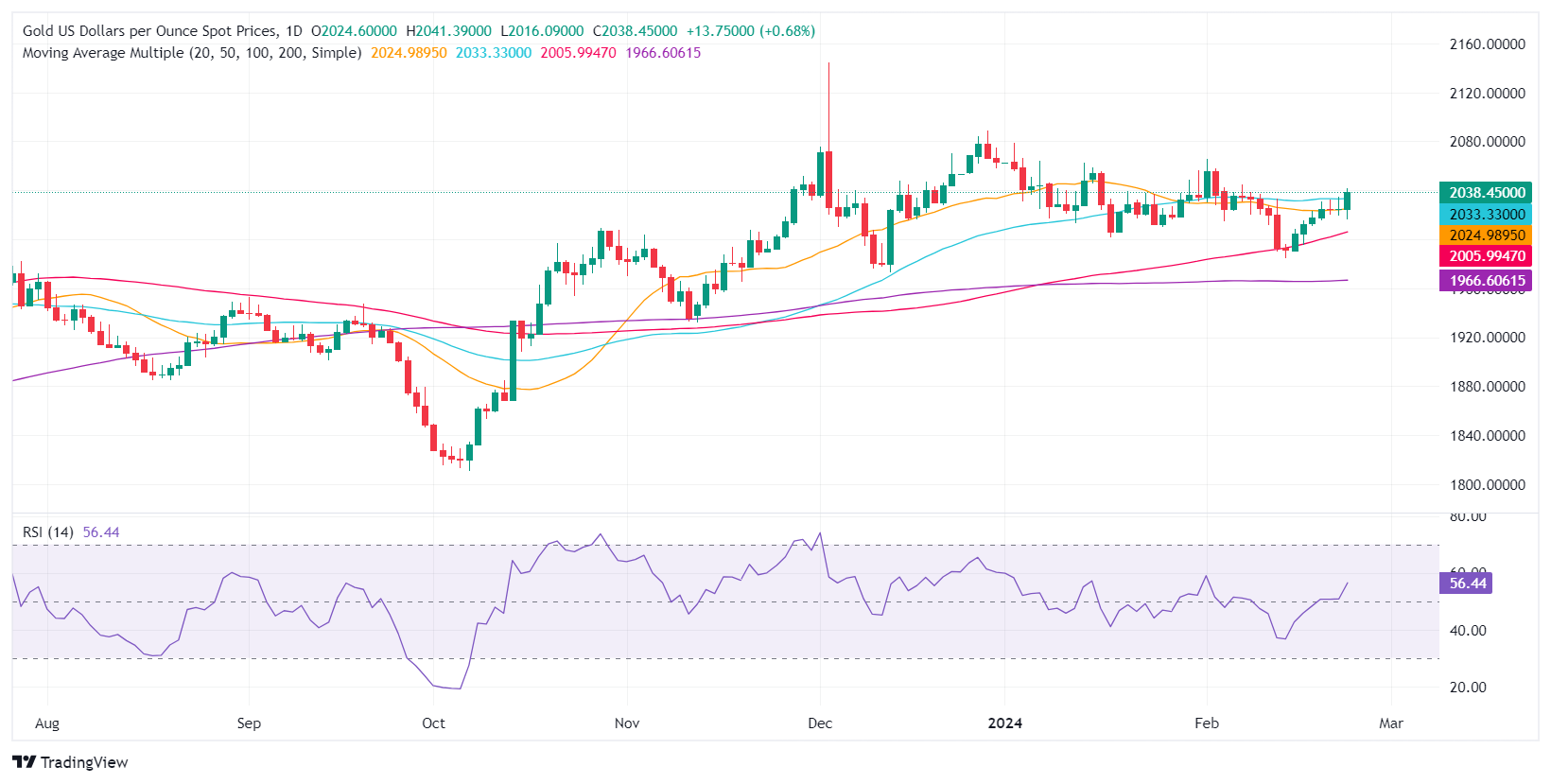Gold price rallies, eyeing weekly finish in the green amid lower US bond yields

- Gold price surges, buoyed by a decline in US Treasury yields and optimistic market conditions.
- Risk-on mood prevails, yet Gold attracts investors, defying typical safe-haven asset trends.
- Market sentiment adjusts to Fed’s cautious stance with expectations of significant rate easing by year-end.
Gold price resumes its weekly uptrend on Friday and is set to finish the week in the green, taking advantage of the fall in US Treasury bond yields amid quiet news flows. Federal Reserve officials continued to cross the wires, led by New York Fed President John Williams, who aligned with his colleagues’ recent comments. The XAU/USD exchanges hands at $2,038, up 0.70%.
The financial markets are in a risk-on mode, which usually translates to “less” appetite for safe-haven assets, but not today as Gold remains underpinned by dropping US Treasury yields. The 10-year benchmark note erased most of its gains, falling three and a half basis points, down to 4.248%. Despite Fed officials delivering a “slightly” hawkish tone recently, this was well received by investors who trimmed bets on Fed interest rate cuts and expect 93 basis points of easing toward the year’s end.
Daily digest market movers: Gold advance prompted by soft US Dollar undermined by lower US yields
- The Federal Open Market Committee (FOMC) minutes for January showed that policymakers remain hesitant to cut rates, adopting a cautious approach amid the latest resurgence of inflationary measures. Although acknowledging that the risks of achieving both mandates are more balanced, they would remain “highly attentive” to inflation. This is at the expense of economic risks being tilted to the downside.
- Besides that, the US labor market remains strong after the latest Initial Jobless Claims data saw fewer Americans applying for unemployment benefits.
- US business activity moderated in February, revealed S&P Global. The Services and Composite Indices expanded below the previous month’s reading, though Manufacturing surprisingly jumped, exiting contractionary territory.
- The CME FedWatch Tool sees traders expect the first 25 bps rate cut by the Fed in June 2024.
- Investors are pricing in 95 basis points of easing throughout 2024.
- The US Dollar Index, tracking the performance of the US Dollar against a basket of six major currencies, is currently trading near 103.90, down 0.04%.
- The Federal New York Fed President John Williams said the Fed is on track to cut interest rates “later this year.” He noted that the progress of inflation toward the central bank’s 2% target would be “bumpy,” but overall, the economy is headed “in the right direction.”
Technical analysis: Gold surpasses the 50-day SMA eyes on $2,050
Gold has shifted to a neutral-upwards bias as it hurdles the 50-day Simple Moving Average (SMA) at $2,033.75, opening the door to challenge the $2,050 figure. Once those levels are cleared, up next would be the February 1 high at $2,065.60, ahead of the December 28 high at $2,088.48.
On the flip side, sellers dragging the XAU/USD spot price below the 50-day SMA could pave the way to test the October 27 daily high-turned-support at $2,009.42. A breach of the latter will expose the 100-day SMA at $2,002.05. The next stop would be the December 13 low at $1,973.13, followed by the 200-day SMA at $1,965.86.
XAU/USD Price Action – Daily Chart
Gold FAQs
Gold has played a key role in human’s history as it has been widely used as a store of value and medium of exchange. Currently, apart from its shine and usage for jewelry, the precious metal is widely seen as a safe-haven asset, meaning that it is considered a good investment during turbulent times. Gold is also widely seen as a hedge against inflation and against depreciating currencies as it doesn’t rely on any specific issuer or government.
Central banks are the biggest Gold holders. In their aim to support their currencies in turbulent times, central banks tend to diversify their reserves and buy Gold to improve the perceived strength of the economy and the currency. High Gold reserves can be a source of trust for a country’s solvency. Central banks added 1,136 tonnes of Gold worth around $70 billion to their reserves in 2022, according to data from the World Gold Council. This is the highest yearly purchase since records began. Central banks from emerging economies such as China, India and Turkey are quickly increasing their Gold reserves.
Gold has an inverse correlation with the US Dollar and US Treasuries, which are both major reserve and safe-haven assets. When the Dollar depreciates, Gold tends to rise, enabling investors and central banks to diversify their assets in turbulent times. Gold is also inversely correlated with risk assets. A rally in the stock market tends to weaken Gold price, while sell-offs in riskier markets tend to favor the precious metal.
The price can move due to a wide range of factors. Geopolitical instability or fears of a deep recession can quickly make Gold price escalate due to its safe-haven status. As a yield-less asset, Gold tends to rise with lower interest rates, while higher cost of money usually weighs down on the yellow metal. Still, most moves depend on how the US Dollar (USD) behaves as the asset is priced in dollars (XAU/USD). A strong Dollar tends to keep the price of Gold controlled, whereas a weaker Dollar is likely to push Gold prices up.
